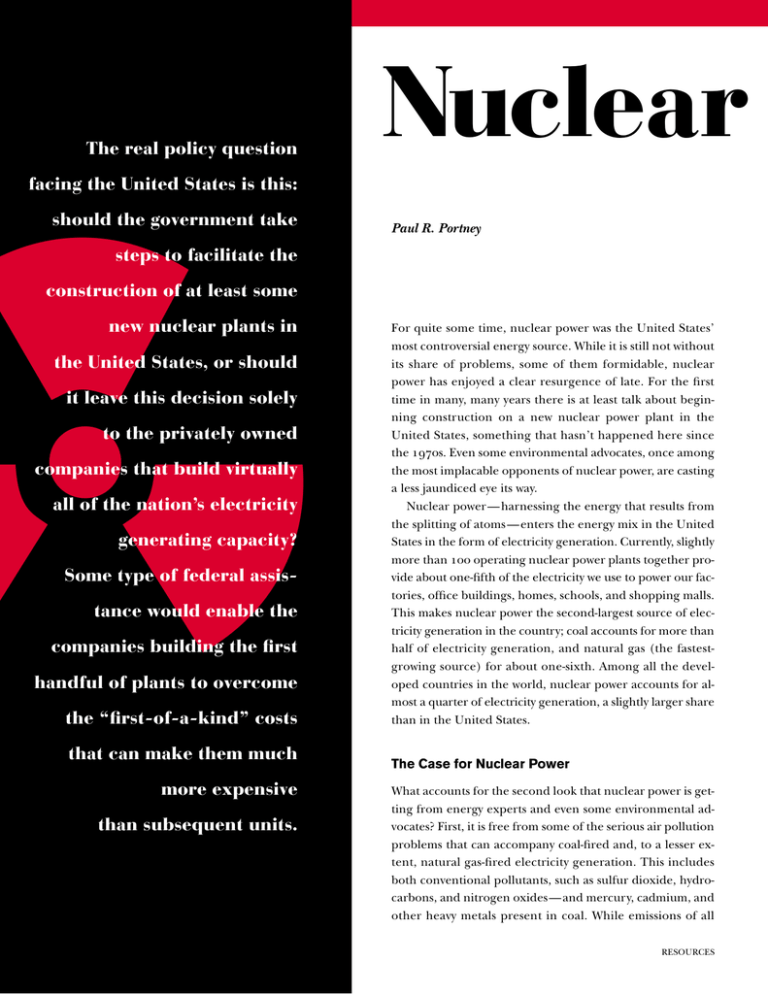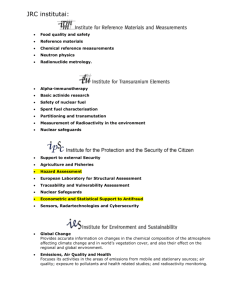Nuclear
advertisement

The real policy question Nuclear facing the United States is this: should the government take Paul R. Portney steps to facilitate the construction of at least some new nuclear plants in the United States, or should it leave this decision solely to the privately owned companies that build virtually all of the nation’s electricity generating capacity? Some type of federal assis- tance would enable the companies building the first handful of plants to overcome the “first-of-a-kind” costs that can make them much more expensive than subsequent units. 28 For quite some time, nuclear power was the United States’ most controversial energy source. While it is still not without its share of problems, some of them formidable, nuclear power has enjoyed a clear resurgence of late. For the first time in many, many years there is at least talk about beginning construction on a new nuclear power plant in the United States, something that hasn’t happened here since the 1970s. Even some environmental advocates, once among the most implacable opponents of nuclear power, are casting a less jaundiced eye its way. Nuclear power — harnessing the energy that results from the splitting of atoms — enters the energy mix in the United States in the form of electricity generation. Currently, slightly more than 100 operating nuclear power plants together provide about one-fifth of the electricity we use to power our factories, office buildings, homes, schools, and shopping malls. This makes nuclear power the second-largest source of electricity generation in the country; coal accounts for more than half of electricity generation, and natural gas (the fastestgrowing source) for about one-sixth. Among all the developed countries in the world, nuclear power accounts for almost a quarter of electricity generation, a slightly larger share than in the United States. The Case for Nuclear Power What accounts for the second look that nuclear power is getting from energy experts and even some environmental advocates? First, it is free from some of the serious air pollution problems that can accompany coal-fired and, to a lesser extent, natural gas-fired electricity generation. This includes both conventional pollutants, such as sulfur dioxide, hydrocarbons, and nitrogen oxides — and mercury, cadmium, and other heavy metals present in coal. While emissions of all RESOURCES Power C L E A N , C O S T L Y, A N D C O N T R O V E R S I A L these pollutants have been reduced significantly since the 1970 Clean Air Act took effect, electricity generation is still a major source of them all. Much more importantly, nuclear power is carbon-free. That is, unlike coal, natural gas, and petroleum, it does not release carbon dioxide into the atmosphere in the process of generating electricity. At a time when there is growing concern about the link between carbon dioxide and other greenhouses gases on the one hand and the warming of our planet on the other, this advantage of nuclear power has begun to loom larger. A second advantage of nuclear power has to do with energy security. Concerns have existed since the early 1970s about the extent to which the United States is dependent upon petroleum imports to fuel our transportation sector, particularly from countries in the Middle East. For the first time, a concern about possible import dependence has begun to extend to the electricity generation sector. This is not because petroleum is used for electricity generation — its role there has almost disappeared. Rather, the concern is that natural gas production in the United States cannot keep pace with demand growth and that an ever-greater share of the natural gas we use for home heating and industrial production, as well as for electricity generation, will have to come from abroad (including from some of the same countries whose share of world oil reserves makes us nervous). Because of the likely adequacy of North American uranium reserves, this is not a concern for nuclear power (nor is it for coal, for which domestic reserves are ample). There is a third attraction to nuclear power, though it currently pertains only to those plants that are already in operation — once built and paid for (a big qualification, as we’ll see below), these plants are extremely inexpensive to operate. Indeed, the incremental cost of generating electricity from an existing nuclear plant is on the order of 1.5 cents for each WINTER 2005 kilowatt-hour (kWh) of electricity generated. This compares with about 2 cents/kWh for a conventional coal plant and, at current natural gas prices, about 3.5 cents/kWh for a natural gas plant. With the average retail cost of electricity in the United States currently standing at 7.5 cents/kWh, the 100 or so nuclear units in the country are quite profitable. The Case Against Despite those advantages, the last nuclear plant to commence operation in the United States began generating electricity in 1996, and no new plant has been started since 1973. Four liabilities have accounted for this disappointing record. First and perhaps foremost, although nuclear plants are cheap to operate once they are up and running, they are by far the most expensive to build. Based on recent construction costs in Japan and Korea and on estimates from the vendors who would likely build plants in the United States, a new 1,000-megawatt (MW) nuclear power plant would cost on the order of $2 billion and take five years to build. By contrast, a new 1,000-MW pulverized coal plant would cost $1.2 billion and take three to four years to build, and a new clean coal plant (one in which the coal is first converted to cleanerburning natural gas) would cost about $1.4 billion and take four years. Illustrating why natural gas has been the fuel of choice for most of the recent growth in electricity generation, a new 1,000-MW combined-cycle gas turbine can be built in less than two years at a cost of $500 million. The longer construction time and higher capital cost of a new nuclear plant currently more than offset its operating cost advantage. According to a recent report by experts at the Massachusetts Institute of Technology, the “all-in” costs (capital plus operating) of electricity from a new nuclear plant operating for 40 years at 85 percent capacity would be 6.7 cents/kWh. 29 This compares with 4.2 cents/kWh for a coal plant and 4 – 5.6 cents/kWh for a new gas turbine, depending on the assumed price for natural gas. Even if it faced no other obstacles, then, nuclear power would have a formidable economic challenge to overcome. Other obstacles exist, however. For one thing, there has long been concern in the United States about the safety of commercial nuclear reactors, concern that predated the accident at Three Mile Island in 1979, where the core of one of the reactors was damaged. The operating record of the U.S. nuclear industry has improved significantly over the past 20 years, with safety and other related downtime having been reduced to as little at 10 percent at many plants. However, problems still arise from time to time, such as those at the DavisBesse reactor in Ohio, where shoddy maintenance could have led to a serious accident had it not been caught in an inspection. Unless plant safety continues to improve, not merely stay the same, nuclear power faces an uphill climb, economics aside. Opponents of nuclear power also point to the risk that the spent fuel from nuclear plants could be stolen and diverted to the production of so-called dirty bombs or even thermonuclear weapons. While this is a risk that must be taken extraordinarily seriously everywhere, it is a much larger concern outside the United States — especially in countries that have no obvious need for nuclear power. One example is Iran, which has vast natural gas reserves that could be used for electricity generation, but which has elected not only to build nuclear power plants, but also to do so using a fuel cycle providing easier access to the plutonium required for nuclear weapons. The final challenge associated with nuclear power has also to do with spent wastes — namely, where in the world they will be stored. Currently, almost all the wastes that result from nuclear-powered electricity generation are being stored on the grounds of the power plants. No one believes this is the best place for these wastes, and at some plants storage capacity has been or soon will be exceeded. For this reason, the federal government committed long ago to build and open a highlevel nuclear waste repository. Yucca Mountain, Nevada, was chosen as its site, and the repository has now been completed, at an eventual cost to the public of $50 billion, perhaps more. There’s just one problem. Nevadans have no interest in being home to these wastes and have been successful in preventing the first shipments to Yucca Mountain, aided by a recent U.S. Court of Appeals ruling that the Environmental Protection Agency erred in establishing a safety standard Congress had directed it to set. Until and unless this stalemate is resolved, the future of new nuclear plants — not 30 to mention the continued viability of the existing ones — is uncertain. Policy Issues Yucca Mountain notwithstanding, the real policy question facing the United States is this: should the government take steps to facilitate the construction of at least some new nuclear plants in the United States, or should it leave this decision solely to the privately owned companies that build virtually all of the nation’s electricity generating capacity? Some type of federal assistance would enable the companies building the first handful of plants (likely in consortia) to overcome the “first-of-a-kind” costs that can make them much more expensive than subsequent units. If these latter units then became as cheap as some vendors suggest, their upfront costs would be quite competitive with new clean coal and even pulverized coal units and perhaps even competitive with natural gas plants on an all-in basis if gas prices remain high. Not surprisingly, the industry is seeking such government assistance in the form of a contribution toward the cost of building the first new plants, like the production tax credit afforded to wind power and other emission-free sources, as well as possible loan guarantees and other protections. Government subsidies are not the only way to ensure that nuclear power gets to compete as a clean and secure source of electricity generation, of course. In the same way that the conventional air pollution problems associated with coalfired generation have been substantially internalized through federal emissions-control requirements, so too could the comparable externalities associated with climate change. This could be done through a carbon tax or through a mandatory cap-and-trade program that forced both coal- and gas-fired plants to reduce their carbon dioxide emissions. Similarly, the energy security costs associated with an increasingly international market for natural gas could be internalized through an appropriate tax. Once these external costs had been internalized, along with those associated with nuclear power and other sources of electricity generation, of course, the government could step aside and let nuclear battle with coal, natural gas, wind, biomass, solar, and any other means of power production one could think up. Far from the “dead duck” nuclear power was once proclaimed to be, it has arisen phoenix-like from the ashes. Whether this revival will extend to a new fleet of commercial nuclear reactors in the United States depends in large part upon how the inherent problems are resolved and how a nuclear program would be implemented. ■ RESOURCES



